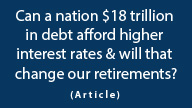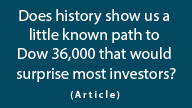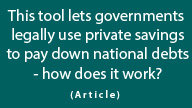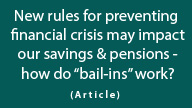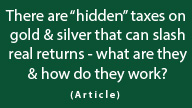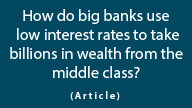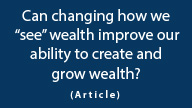A Financial "Perfect Storm" May Be Brewing
by Daniel R. Amerman, CFA
Below is the 2nd half of this article. If you would prefer to read (or link) the article in single page form, the private one page version for subscribers can be found here:
7) Heightened Risks From Currency Warfare
Also of particular concern is a truth which former Bank of England head Mervyn King can candidly speak about now that he is out of office, which is that quantitative easing can become currency warfare, and indeed, there is a case that a de facto currency war already exists (Bloomberg article link). That is, nations are seeking competitive advantage for their own economies by creating large sums of money in order to make their currency cheaper than other countries, meaning their exports increase and their imports decrease. The issue is that because this competition is an inherently unstable and dangerous process, currency wars can spin out of control, and quite quickly.
Of crucial importance is that there is direct connection between currency warfare and the other "systems". Quantitative easing typically involves creating money to buy government bonds and other securities, and it is done on a large scale. This pushes prices further upward – increasing the magnitude of a market correction. Meanwhile these same actions simultaneously reduce the supply of assets available to private investors – increasing liquidity crunch risk. So nations seeking to competitively devalue their currencies directly feed energy into the other "weather systems".
Again, the "perfect storm" analogy seems to be an apt one. Deliberately pushing stock and bond prices higher than they should be creates markets that are inherently unstable. Liquidity crunches are destabilizing and dangerous. Currency warfare is destabilizing and dangerous. But what is far worse is when those three destabilizing "weather systems" not only merge together but also feed "energy" to each other and as a result they triple (or more) in strength.
8) The Greek"Trigger"
While the 1991 "perfect storm" was the convergence of multiple weather systems, it is the eighth financial "weather system" of 2015 that truly brings things into dangerous territory in the near term. This eighth source of destructive financial energy is the profoundly destabilizing event of a potential Greek default, and the related but not identical risk of a Greek exit from the eurozone.
The political change in Greece has created a sharp new risk for the euro and the world, as discussed in my articles here and here. If it is a Greek crisis by itself – the general consensus thus far has been that the system could quite likely handle the stress.
But what needs to be understood is that this consensus was based on the relatively more stable system that existed as of a month ago or three months ago. Under that previous set of circumstances, we could liken Greece to a potential "Category One" hurricane blowing around in isolation off the Atlantic coast, where even if it did eventually make landfall, it wouldn't necessarily be a world changer at all. The damage would instead likely be fairly limited and quite containable.
The problem is if a Category One Greek hurricane runs into a liquidity crunch, at the same time that the ETF structure is being stressed globally, at the same time that investors are experiencing genuine fear and heading for the exits, and at the same time that we have currency warfare in effect on a global basis – this could set off a scenario that rivals or surpasses the financial crisis of 2008, and it could happen very, very quickly indeed.
It's also important to understand that while many view Greece to be a European problem, these "weather systems" are global in nature. That is, if Greece does "trigger" a financial crisis – that crisis won't necessarily initially manifest in Europe, and it may not happen instantly. As one possible scenario, a Greek default pushes the euro down sharply. As a defensive currency warfare measure, other nations enter into or increase their degree of quantitative easing – such as the United States, or Japan, or Australia or Canada. This then feeds the "energy", in the form of still higher asset prices and still lower liquidity. This increased instability could then quickly set off by a further deterioration in Europe, or it could be set off by something else altogether, months or years later, in an entirely different part of the world.
A Radar Map That Is "Lighting Up"
Per the International Monetary Fund, and as explored in this article (link here), modern severe financial crises can stem from the intersection of three separate but deeply intertwined risks – those of contagion risk, liquidity risk and counterparty risk.
And this "perfect storm" that is developing is starting to look like it could potentially trigger all three of these risks.
Now, does this mean a certain end of the financial world as we know it?
No.
To keep with the weather analogy, what it means is that we seem to be at that place where "high energy systems" and fronts have been popping up all over the place, and really getting those meteorologists on the Weather Channel all worked up. They can't give us a forecast with certainty, the models are conflicting, they don't know the exact storm tracks, and they don't know all the details about what is strengthening or weakening.
But what they do know is that a previously relatively boring radar map has been replaced by surging energy and a multiplying array of new systems. They know that a rapidly evolving situation has come into existence where an event of historic magnitude is entirely possible, and it can happen with great speed.
In other words, this analysis isn't a forecast or a "call", but rather a "head's up" that our radar map is starting to light up from one end to the other with notable developments.
Another consideration is what I covered in my most recent article (link here), where I discuss the almost total disconnect between what the general public thinks is going on with the markets, and what many highly knowledgeable insiders are aware of. And this developing financial storm is a very good example of that.
As a Chartered Financial Analyst I receive a daily email from my professional organization that contains the news items considered to be of the greatest relevance for institutional investors around the world.
So what are the financial institutions watching with great interest at this moment?
Well, the #3 article for May 12th was concerning the comments by ESMA chair Steven Maijoor on how central banking policies could create a liquidity crunch.
The #2 article for May 13th centered around the warning from the former Governor of the Bank of England about the danger of currency warfare exacerbating financial stability risk.
The #1 article for May 14th was about the scramble by bond ETFs in the United States to try to head off the danger of a liquidity crunch by putting lines of credit in place.
So when it comes to the institutional investors of the world, key people at the major institutions receive the same emails that I do each morning, and I think it is fair to say that the global institutional investor community is watching the radar map and these developing "weather systems" with keen interest.
Keep an eye on the radar, this could get interesting.
 What you have just read is an "eye-opener" about one aspect of the often hidden redistributions of wealth that go on all around us, every day.
What you have just read is an "eye-opener" about one aspect of the often hidden redistributions of wealth that go on all around us, every day.
 A personal retirement "eye-opener" linked here shows how the government's actions to reduce interest payments on the national debt can reduce retirement investment wealth accumulation by 95% over thirty years, and how the government is reducing standards of living for those already retired by almost 50%.
A personal retirement "eye-opener" linked here shows how the government's actions to reduce interest payments on the national debt can reduce retirement investment wealth accumulation by 95% over thirty years, and how the government is reducing standards of living for those already retired by almost 50%.
 An "eye-opener" tutorial of a quite different kind is linked here, and it shows how governments use inflation and the tax code to take wealth from unknowing precious metals investors, so that the higher inflation goes, and the higher precious metals prices climb - the more of the investor's net worth ends up with the government.
An "eye-opener" tutorial of a quite different kind is linked here, and it shows how governments use inflation and the tax code to take wealth from unknowing precious metals investors, so that the higher inflation goes, and the higher precious metals prices climb - the more of the investor's net worth ends up with the government.
 When we look at all government retirement promises over the coming decades – the total is simply unpayable. As explored in the "eye opener" linked here, this means that there is a high probability of an eventual tax code "revolution" that could rewrite all the rules when it comes to the future treatment of our current retirement accounts.
When we look at all government retirement promises over the coming decades – the total is simply unpayable. As explored in the "eye opener" linked here, this means that there is a high probability of an eventual tax code "revolution" that could rewrite all the rules when it comes to the future treatment of our current retirement accounts.







If you find these "eye-openers" to be interesting and useful, there is an entire free book of them available here, including many that are only in the book. The advantage to the book is that the tutorials can build on each other, so that in combination we can find ways of defending ourselves, and even learn how to position ourselves to benefit from the hidden redistributions of wealth.


